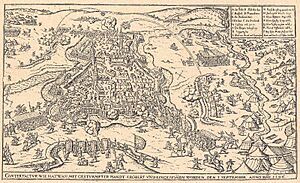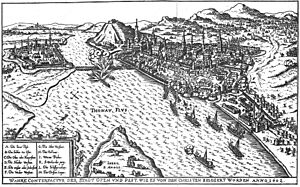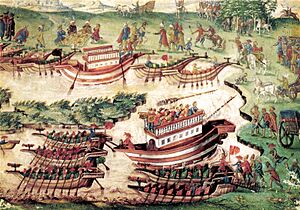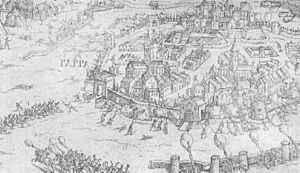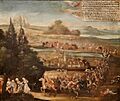Long Turkish War facts for kids
Quick facts for kids Long WarFifteen Years' War of Hungary |
|||||||
|---|---|---|---|---|---|---|---|
| Part of the Ottoman-Habsburg wars | |||||||
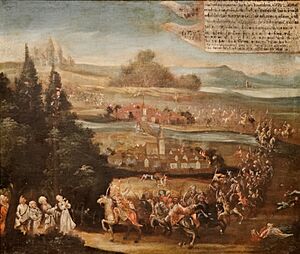 Allegory of the Turkish war – The declaration of war before Constantinople |
|||||||
|
|||||||
| Belligerents | |||||||
|
• Khanate of Crimea | ||||||
| Commanders and leaders | |||||||
| Rudolf II Vincenzo I Gonzaga Hermann Christof von Russwurm Karl von Mansfeld (DOW) Michael the Brave † Ruprecht von Eggenberg Giorgio Basta István Bocskai Starina Novak |
Murad III Mehmed III Ahmed I Koca Sinan Pasha Cığalazade Yusuf Sinan Pasha Lala Mehmed Pasha Tiryaki Hasan Pasha Damat Ibrahim Pasha Telli Hasan Pasha † |
||||||
| Strength | |||||||
| More than 100,000 men | 160,000–180,000 | ||||||
| Casualties and losses | |||||||
| Unknown, heavy | Unknown, heavy | ||||||
The Long War was a big conflict between two powerful empires: the Habsburg Monarchy and the Ottoman Empire. It lasted from 1593 to 1606. This war was mostly fought over control of important regions like Wallachia, Transylvania, and Moldavia. These areas are in what is now Hungary, Romania, and other parts of the Balkans.
Sometimes, people call it the Fifteen Years' War because some fighting started earlier, around 1591–1592. In Turkey, it's known as the Ottoman–Austrian War of 1593–1606. This war was a major test of strength between these two empires during that time. Many battles and sieges happened, but neither side gained a lot of new land.
Contents
What Was the Long War About?
The main groups fighting in the Long War were the Habsburg Monarchy and its allies against the Ottoman Empire. The Habsburgs were a powerful European royal family. Their allies included the Principality of Transylvania, Wallachia, and Moldavia. Other European states like Ferrara, Tuscany, Mantua, and the Papal States also helped the Habsburg side.
How the War Was Paid For
Fighting a war costs a lot of money. The Holy Roman Emperor, Rudolf II, received a lot of support for this war. The German parliament, called the Reichstag, agreed to give money for the war. They promised about 20 million florins, and most of it was actually paid. Smaller German princes also contributed millions of florins. The Habsburg Monarchy itself raised about 20 million florins. Other countries like Italy and Spain also sent money to help the Habsburgs.
Before the War Started
Before the main war began, there were smaller fights along the border between the Habsburg and Ottoman lands. These fights became more frequent from 1591. In 1592, an important fort called Bihać was captured by the Ottomans after a long siege. This event showed that tensions were rising.
Key Events of the War
Battles of 1593
In the spring of 1593, Ottoman forces attacked the city of Sisak in Croatia. This led to the Battle of Sisak, where Christian forces won a big victory on June 22, 1593. This win marked the end of a long period of fighting between Croatia and the Ottomans.
The Long War officially began on July 29, 1593. The Ottoman army, led by Sinan Pasha, started a major campaign. They captured important cities like Győr and Komárno in 1594.
Events of 1594
In early 1594, Serbs living in the Banat region rebelled against the Ottomans. They carried special war flags during their uprising. Christian leaders supported this rebellion. In response, the Ottoman Grand Vizier, Koca Sinan Pasha, ordered that the relics of Saint Sava be moved from a monastery to Belgrade. Along the way, the Ottoman convoy harmed people as a warning. On April 27, the Ottomans publicly burned the relics of Saint Sava on a hill called Vračar plateau. They scattered the ashes to show their power.
Fighting in 1595 and 1596
In 1595, European Christian powers formed an alliance called the Holy League to fight the Ottoman Empire. Pope Clement VIII helped organize this alliance. The Holy Roman Emperor, Rudolf II, and Sigismund Báthory of Transylvania signed a treaty. Later, Aron Vodă of Moldavia and Michael the Brave of Wallachia also joined. Spain sent an army of experienced soldiers from the Netherlands to help.
The Ottomans wanted to capture Vienna, a major Habsburg city. The Habsburgs wanted to take back parts of Hungary that the Ottomans controlled. Controlling the Danube River and its fortresses was very important for both sides. The war was fought in many areas, including Hungary, Croatia, and Wallachia.
In 1595, Christian forces, led by Karl von Mansfeld, captured Esztergom and Visegrád. These were important forts on the Danube. However, they did not attack the key fortress of Buda. The Ottomans then attacked and captured Eger in 1596.
In the Balkans, a Spanish fleet attacked Patras, an Ottoman town, in 1595. This was in response to Ottoman raids on Italian coasts. The attack was so big that the Ottoman Sultan, Murad III, considered punishing all Christians in Constantinople. He decided instead to make all unmarried Greek people leave the city. Spanish ships continued to raid Ottoman waters in the following years.
On the eastern side of the war, Michael the Brave, the ruler of Wallachia, began his own attacks against the Ottomans in late 1594. He captured several castles along the Lower Danube, including Giurgiu and Silistra. His allies from Moldavia also defeated Ottoman armies. Michael continued his attacks deep into Ottoman territory, even reaching close to the Ottoman capital, Constantinople.
However, Michael was forced to retreat. The Ottomans then launched a huge counter-attack with 100,000 soldiers. They wanted to take back their lands and conquer Wallachia. At first, they succeeded, capturing Giurgiu, Bucharest, and Târgoviște. Michael's army fought bravely at the Battle of Călugăreni in August 1595. The Ottomans became overconfident and stopped chasing Michael's army. Michael waited for help from his allies. When it arrived, he launched a surprise counter-attack. He defeated the Ottomans in three battles: at Târgoviște (October 18), Bucharest (October 22), and Giurgiu (October 26). The Battle of Giurgiu was especially bad for the Ottomans, who had to retreat in a hurry.
The war between Wallachia and the Ottomans continued until 1599. Michael could not keep fighting because his allies did not provide enough support.
A major turning point in the war was the Battle of Mezőkeresztes in Hungary, from October 24–26, 1596. A combined Habsburg-Transylvanian army of about 45,000-50,000 soldiers fought the Ottoman army. The Christian soldiers thought they had won and started to loot the Ottoman camp. This mistake allowed the Ottomans to defeat them. This was the first big battle in Central Europe between a large Christian army and the Ottoman army since the Battle of Mohács. Despite this loss, the Austrians recaptured Győr and Komarom in 1598.
In 1599, the Ottomans and their allies attacked towns in what is now Slovakia. They captured thousands of people.
Final Years: 1601–1606
In August 1601, at the Battle of Guruslău, Giorgio Basta and Michael the Brave defeated Hungarian nobles in Transylvania. These nobles had accepted Ottoman and Polish protection. After Michael the Brave was killed, the Transylvanian nobles, led by Mózes Székely, were again defeated in 1603. This time, it was by the Habsburg and Wallachian armies at the Battle of Braşov. It seemed the Habsburgs might win the war.
In September 1601, armies of the Holy Roman Empire tried to capture Nagykanizsa. Even though they had more soldiers, they had to give up the siege two months later because they lost too many men.
The last part of the war, from 1604 to 1606, involved an uprising led by Stephen Bocskay, a prince from Transylvania. Emperor Rudolf started to accuse many nobles of crimes to get money for his treasury. Bocskay, who was a smart leader, resisted this. He gathered unhappy Hungarians and nobles to rebel against the Habsburgs. His troops, supported by Hungarian Hajduk fighters, won some battles. They took back lands from the Habsburg army. Bocskay was declared Prince of Transylvania in 1605, and later Prince of Hungary. The Ottoman Empire offered him a crown, but he refused it because he was Christian. As Prince of Hungary, he agreed to talk with Rudolf II. This led to the Treaty of Vienna (1606).
End of the War
The Long War ended with the Peace of Zsitvatorok on November 11, 1606. Neither side gained much land. The Ottomans kept the forts of Eger, Esztergom, and Kanisza. However, they gave the region of Vác back to Austria. The treaty showed that the Ottomans could not expand further into Habsburg lands. It also showed that Transylvania was too strong for the Habsburgs to control.
Even though Emperor Rudolf didn't achieve all his war goals, he gained some respect for resisting the Ottomans. He presented the war as a victory. The treaty made the border between the Habsburg and Ottoman empires stable for a while. Bocskay also kept his independence, but he agreed to give up the title of "King of Hungary."
After the war, Rudolf faced problems within his own family. He had huge debts from the war. He also made deals with Hungarian nobles and disappointed the German princes who had helped pay for the war. Once peace was made with the Ottomans, the Habsburg family started fighting among themselves. This led to a struggle over who would be Rudolf's successor, as he had no children. This conflict is known as the Brothers' Quarrel.
Major Battles of the War
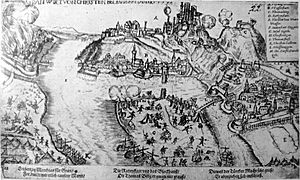
- Battle of Sisak
- Siege of Veszprém
- Siege of Tata (1593)
- Battle of Székesfehérvár (1593)
- Battle of Romhány (1593)
- Uprising in Banat
- Siege of Győr (1594)
- Battle of Călugăreni
- Battle of Giurgiu
- Siege of Esztergom (1596)
- Battle of Brest (1596)
- Siege of Eger (1596)
- Battle of Keresztes
- Serb Uprising of 1596–97
- Siege of Tata (1597)
- Siege of Győr (1598)
- Siege of Buda (1599)
- Battle of Şelimbăr
- Kanizsa
- Battle of Mirăslău
- Battle of Guruslău
- Siege of Székesfehérvár (1601)
- Battle of Braşov
- Siege of Buda (1603)
Images for kids


